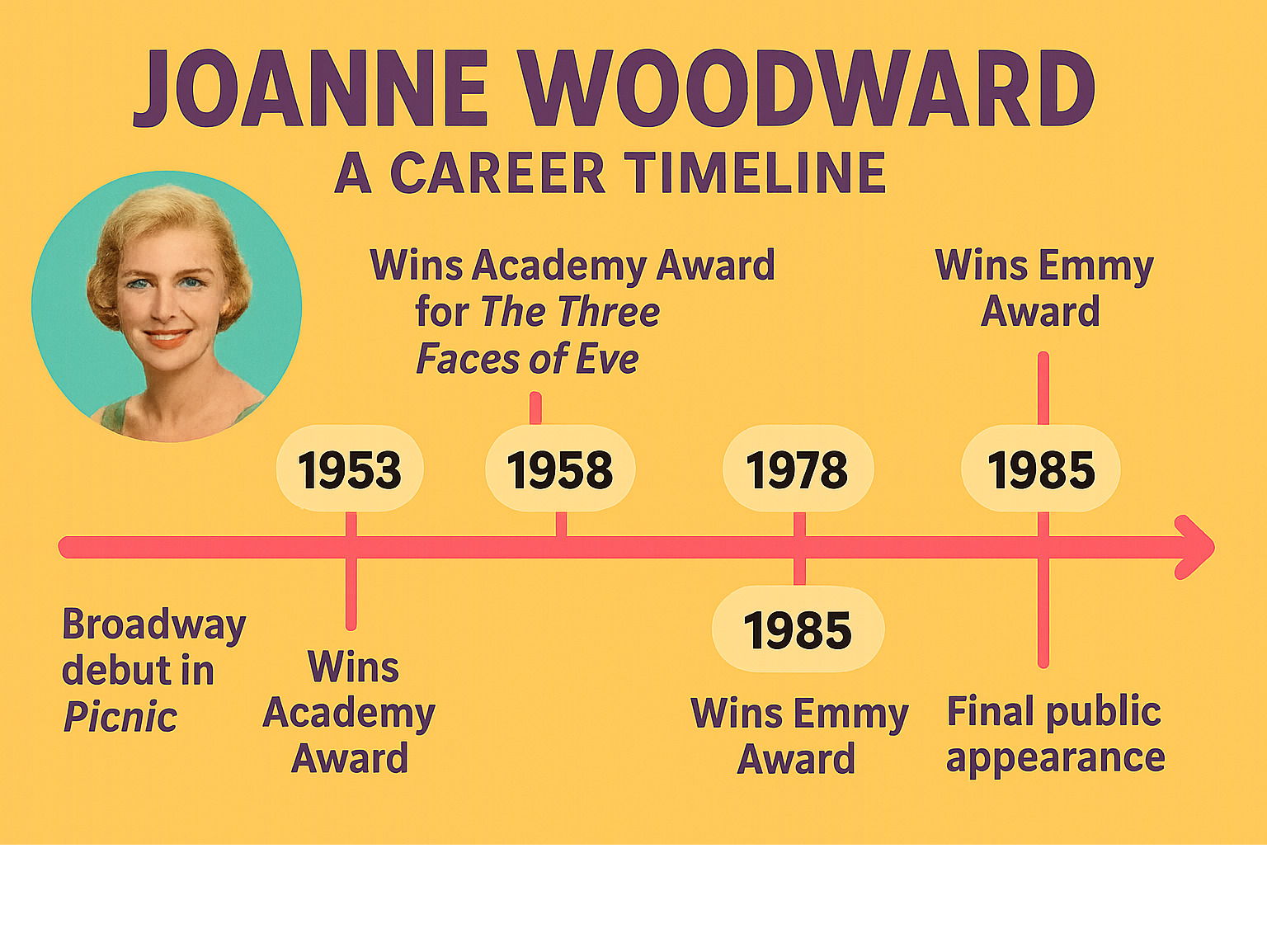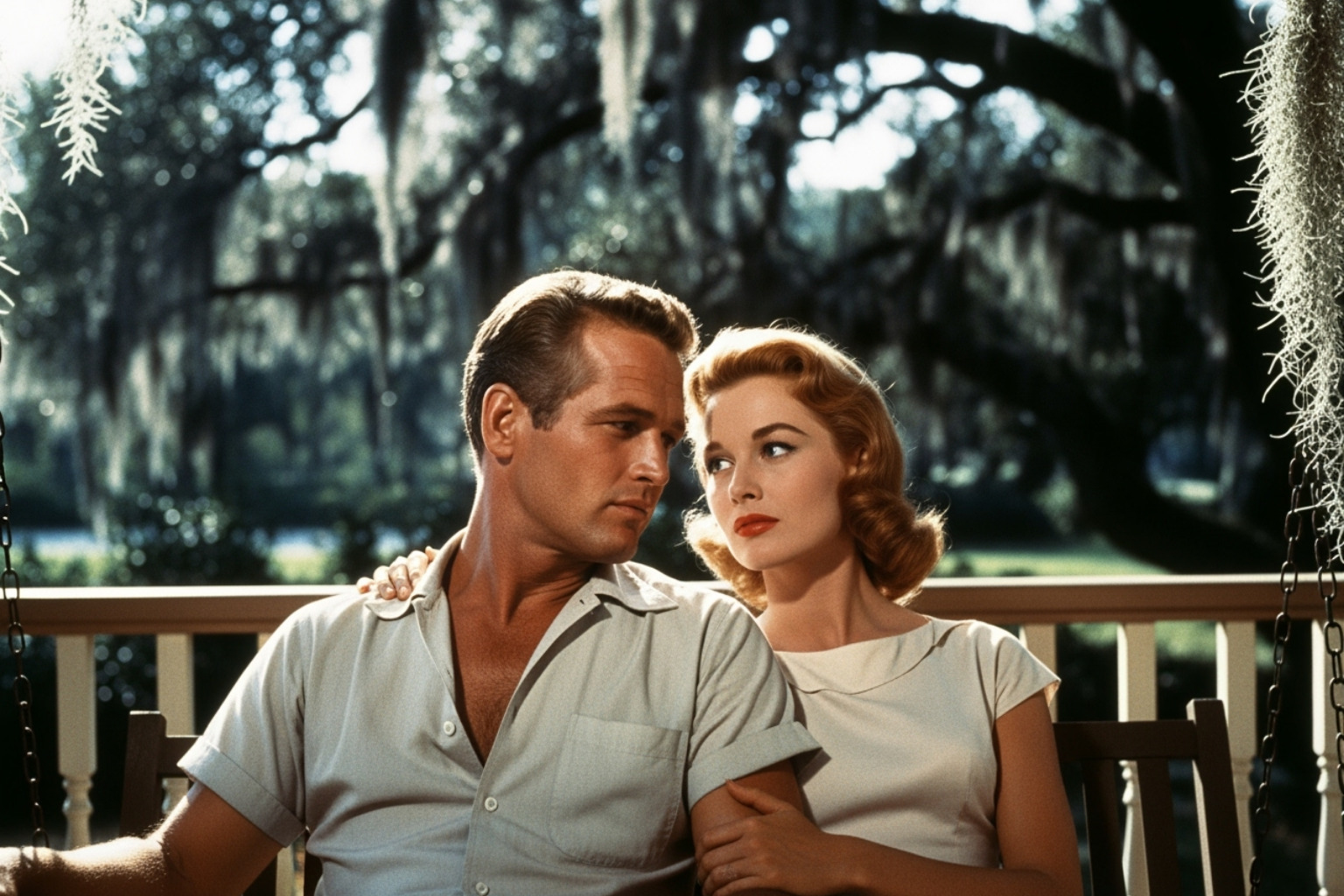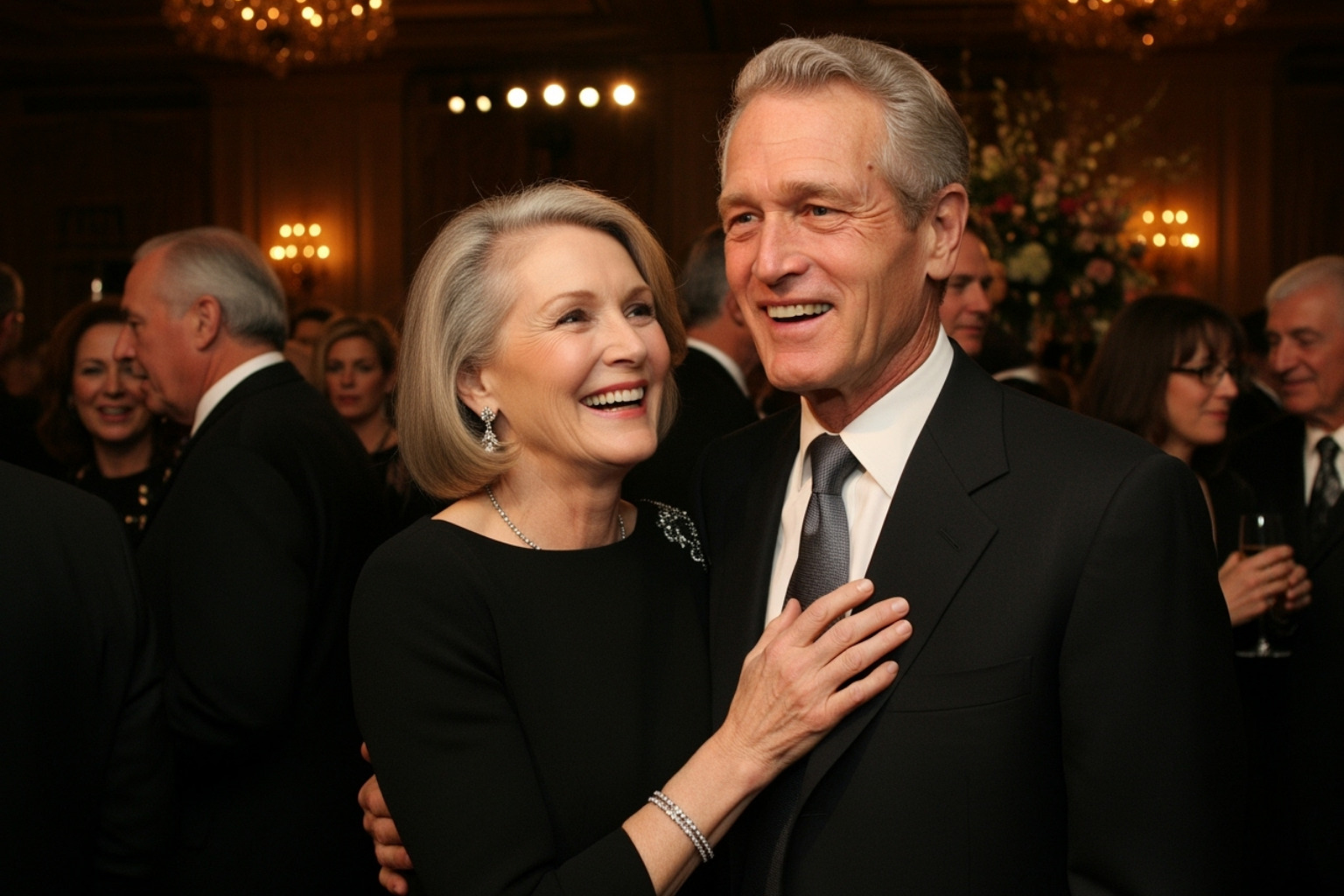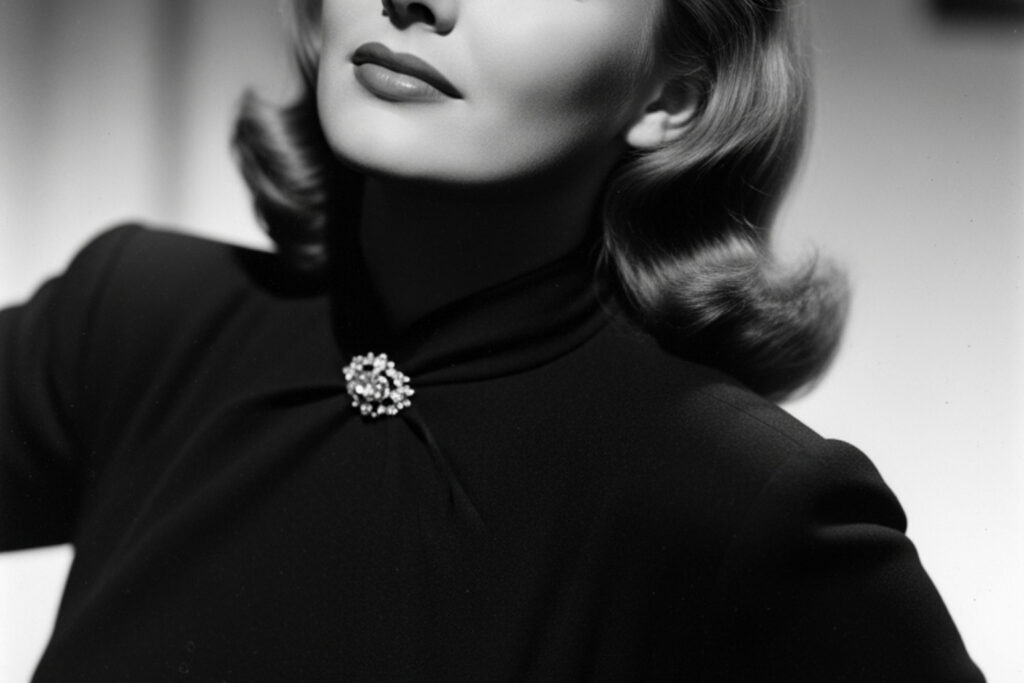Who Is Joanne Woodward: Hollywood’s Timeless Icon
Joanne Woodward is an American actress who became one of Hollywood’s most respected performers, winning an Academy Award for Best Actress in 1958 for “The Three Faces of Eve.” Born in 1930, she was married to legendary actor Paul Newman for 50 years until his death in 2008, making them one of Hollywood’s most enduring couples.
Quick Facts About Joanne Woodward:
- Born: February 27, 1930 (age 95) in Thomasville, Georgia
- Major Achievement: Academy Award winner for “The Three Faces of Eve” (1958)
- Marriage: 50-year marriage to Paul Newman (1958-2008)
- Awards: 1 Oscar, 3 Emmy Awards, 3 Golden Globe Awards, Kennedy Center Honors
- Legacy: Pioneered complex female roles in 1950s Hollywood
- Current Status: Living privately after Alzheimer’s diagnosis in 2007
Joanne Woodward distinguished herself from other actresses of her era by taking on spirited and strong roles that defied the typical glamorous, helpless female characters that dominated 1950s Hollywood. Her natural beauty and powerful performances in films like “Rachel, Rachel” and “Mr. & Mrs. Bridge” earned her critical acclaim throughout her career.
Beyond her acting achievements, Woodward became known for her philanthropic work alongside Newman, including their involvement with Newman’s Own Foundation and the Hole in the Wall Gang Camp for seriously ill children. As Paul Newman once said about their marriage: “I have steak at home; why go out for hamburger?”
Today, at 95, Joanne Woodward remains one of the last living legends from Hollywood’s Golden Age, having stepped away from public life to focus on her health and family.

joanne woodward basics:
Early Life and Path to the Spotlight
Born Joanne Gignilliat Trimmier Woodward in Thomasville, Georgia, on February 27, 1930, her journey to Hollywood stardom began far from the bright lights of Los Angeles. Growing up in a modest household, she was surrounded by a family that instilled in her a love for performance. In fact, her mother, Elinor, was such a fan of Joan Crawford that she almost named her daughter after the star – a fun anecdote that hints at Joanne Woodward‘s destiny in the film industry.
Her passion for acting was evident from a young age. At nine, she attended the “Gone with the Wind” premiere, boldly hopped into Laurence Olivier’s limousine, and sat on his lap. Olivier later remembered the spirited encounter when they worked together.
Her formal training began at Louisiana State University before she headed to New York City to hone her craft. There, she studied at the prestigious Neighborhood Playhouse School of the Theatre and with the renowned Sanford Meisner, known for his method acting techniques. Meisner even helped her overcome her distinctive Southern drawl, a testament to her dedication and desire for versatility as an actress. She also trained at The Actors Studio, a hotbed for method acting that produced many of Hollywood’s finest.
Joanne Woodward made her Broadway debut in 1953 in the play “Picnic,” a pivotal moment where she also crossed paths with a charismatic young actor named Paul Newman. Though he was the star and she an understudy, it was the beginning of a legendary connection.
Her early career also saw her grace the small screen in numerous television appearances, including “Kraft Television Theatre” and “Omnibus.” Her first major film role came in 1955 with “Count Three and Pray,” followed by “A Kiss Before Dying.” These early roles began to showcase her unique ability to portray complex characters, setting her apart from many of her contemporaries. Her growing recognition was cemented when she received a star on the Hollywood Walk of Fame on February 9, 1960, becoming one of the first celebrities to be honored. You can dig into the History of the Walk of Fame to see how this iconic tradition began.
Early Career and Distinguishing Style
What truly set Joanne Woodward apart in the competitive landscape of 1950s Hollywood was her discerning choice of roles and her distinctive acting style. While many actresses were cast in glamorous, often helpless, roles that were a trademark of the era, Woodward gravitated towards more spirited and strong female characters. We see this in her early work, where she often played women with grit and intelligence, defying typical stereotypes.
Her natural beauty was undeniable, but it was her commitment to her craft and nuanced portrayals that garnered respect. She wasn’t just a pretty face; she was an actress who used method acting to bring authenticity to her performances. This commitment to playing highly respected roles made her a Celeb Faves among critics and audiences who appreciated her depth.
The Role That Changed Everything: The Three Faces of Eve
While her early roles showcased her promise, it was her mesmerizing performance in the 1957 film “The Three Faces of Eve” that truly catapulted Joanne Woodward to superstardom and cemented her legacy. In this groundbreaking film, she portrayed Eve White, Eve Black, and Jane – three distinct personalities inhabiting one woman, suffering from what was then known as multiple personality disorder (now recognized as dissociative identity disorder).
Her portrayal was nothing short of extraordinary. She seamlessly transitioned between a timid, repressed housewife, a vivacious and rebellious party-goer, and ultimately, a balanced, integrated woman. This complex character portrayal required immense skill and emotional range, and Woodward delivered a performance that earned her widespread critical acclaim.
The recognition for “The Three Faces of Eve” was swift and monumental. In 1958, Joanne Woodward won the Academy Award for Best Actress, a remarkable achievement that placed her among Hollywood’s elite. If you want to relive that iconic moment, you can watch Joanne Woodward Wins Best Actress : 1958 Oscars. Her win wasn’t just a personal triumph; it was a testament to her ability to bring depth and truth to challenging roles, inspiring countless actors who followed. For those who dream of their own red carpet moment, understanding the preparation involved, from acting to appearance, is key. Check out Red Carpet Ready: Beauty Prep Tips from the Stars for insights into how stars prepare for those big nights.
A Career of Depth and Distinction: The Joanne Woodward Filmography

After her Oscar triumph, Joanne Woodward could have easily settled into predictable Hollywood roles. Instead, she chose a path that would define her entire career – she consistently eschewed typical roles in favor of complex, challenging characters that pushed her artistic boundaries.
Her career evolution beautifully demonstrates how a true artist grows over time. She moved seamlessly between film, television, and stage, often taking on roles behind the camera as well. Whether she was directing, producing, or acting, Joanne Woodward brought the same thoughtful intensity to every project.
What made her filmography so remarkable wasn’t just the quantity of her work, but the quality and variety. She never seemed content to repeat herself, always seeking out stories that mattered and characters that had something important to say.
Notable Film Roles and Awards
The foundation Joanne Woodward built with “The Three Faces of Eve” became the launching pad for an extraordinary body of work. Her collaboration with Paul Newman began professionally in “The Long, Hot Summer” (1958), where their undeniable chemistry lit up the screen and sparked their real-life romance.
“Rachel, Rachel” (1968) marked a deeply personal milestone – directed by Paul Newman, this intimate character study earned her a Golden Globe Award for Best Actress and an Academy Award nomination. The film showcased her ability to find profound meaning in quiet, everyday moments.
Her raw, unflinching performance in “The Effect of Gamma Rays on Man-in-the-Moon Marigolds” (1972) proved she wasn’t afraid to play unlikable characters. Portraying a vulgar, alcoholic mother, she won the Best Actress Award at the Cannes Film Festival, demonstrating her commitment to truth over vanity.
“Summer Wishes, Winter Dreams” (1973) brought another Academy Award nomination, as Joanne Woodward masterfully conveyed the complex emotions of a woman facing midlife disappointment. Her ability to express profound emotional complexity with subtlety became her trademark.
Later in her career, “Mr. & Mrs. Bridge” (1990) reunited her with Newman on screen, earning her a Golden Globe Award and her fourth Academy Award nomination. Even decades into her career, she could still deliver performances that felt fresh and vital.
Her final major film appearance came in “Philadelphia” (1993), where she played the mother of Tom Hanks’ character. It was a fitting end to her film career – a small but memorable role in an important story.
Throughout her career, Joanne Woodward accumulated three Golden Globe Awards and four Academy Award nominations, plus recognition at film festivals worldwide, including the Best Actress Award at the San Sebastián Film Festival in 1960.
A Master of Television and Stage
Joanne Woodward never saw television as a step down from films – she saw it as another canvas for her artistry. Her television work often tackled challenging subjects with the same fearless approach she brought to her film roles.
In “Sybil” (1976), she played a psychiatrist treating a woman with multiple personalities. The role created an interesting parallel to her own breakthrough in “The Three Faces of Eve,” but this time she was the doctor rather than the patient.
Her performance in “Do You Remember Love” (1985) earned her an Emmy Award for portraying a character with Alzheimer’s disease. Looking back, this role carries particular poignancy given her own later diagnosis. Her sensitive, nuanced portrayal helped bring awareness to a condition that many families face.
Joanne Woodward also stepped behind the camera for television, directing episodes of “Family” (1979) and “American Playhouse” (1982). Her two Emmy Awards (1978 and 1985) recognized her significant contributions to television drama.
Theater remained close to her heart throughout her career. Her early performance as Laura Wingfield in “The Glass Menagerie” earned her first acting award, long before Hollywood fame. She never forgot those roots.
From 2001 to 2005, she served as artistic director of the Westport Country Playhouse in Connecticut, a role she and Paul Newman took seriously. She oversaw the adaptation of classic plays and mentored emerging talent, ensuring the theater remained a vital part of the cultural landscape.
Her directing work extended to off-Broadway as well, where she helmed revivals of Clifford Odets’ “Golden Boy” and “Waiting for Lefty” in 1995. These projects showed her deep understanding of American theater and her commitment to bringing important stories to new audiences.
Hollywood’s Golden Couple: A 50-Year Love Story with Paul Newman
In a town of fleeting marriages, Joanne Woodward and Paul Newman’s 50-year love story was legendary. It began like a classic Hollywood script with a chance meeting on Broadway.
The spark first ignited in 1953 during the Broadway production of “Picnic.” Newman commanded the stage as the leading man, while Woodward waited in the wings as an understudy. There was an immediate attraction, but timing wasn’t on their side just yet.
On the set of “The Long, Hot Summer” in 1957, their connection deepened. The on-screen chemistry was real, and though Newman was still married, their bond was too strong to ignore. They married in Las Vegas on January 29, 1958, beginning one of Hollywood’s most enduring love stories.
What made their relationship so special wasn’t just its longevity, but how they chose to live it. While other stars accepted the glitzy Hollywood lifestyle, Joanne Woodward and Newman deliberately chose a different path. They became known as “Hollywood nobility” not for their glamorous parties, but for their quiet dignity and unwavering commitment to each other.
The couple made the bold decision to raise their family in Westport, Connecticut, far from the prying eyes of Hollywood. This wasn’t just about privacy – it was about creating a normal life for their children. Joanne Woodward even took a two-year hiatus from acting in 1963 to focus on motherhood, a choice she later admitted caused some resentment due to its impact on her career. But it perfectly captured her commitment to family over fame.
Collaborations and Family Life with Paul Newman
The professional and personal lives of Joanne Woodward and Paul Newman were beautifully intertwined, creating a partnership that enriched both their individual careers and their shared legacy. Their on-screen chemistry was electric, making audiences believe in love again with every performance.
Their collaborations took two distinct forms: films where they acted together and projects where Newman stepped behind the camera to direct his wife. When they appeared together on screen, magic happened. “The Long, Hot Summer” launched their romantic partnership, followed by memorable performances in “Rally ‘Round the Flag, Boys!” and “From the Terrace.” Later collaborations like “Winning” and “The Drowning Pool” showcased their mature chemistry, while “Mr. & Mrs. Bridge” became a fitting capstone to their on-screen partnership.
| On-Screen Collaborations (Acting Together) | Projects Newman Directed Woodward In |
|---|---|
| The Long, Hot Summer (1958) | Rachel, Rachel (1968) |
| Rally ‘Round the Flag, Boys! (1958) | The Effect of Gamma Rays on Man-in-the-Moon Marigolds (1972) |
| From the Terrace (1960) | The Shadow Box (1980) – TV movie |
| Paris Blues (1961) | Harry & Son (1984) |
| A New Kind of Love (1963) | The Glass Menagerie (1987) |
| Winning (1969) | Mr. & Mrs. Bridge (1990) |
| WUSA (1970) | |
| The Drowning Pool (1975) | |
| Harry & Son (1984) | |
| Mr. & Mrs. Bridge (1990) |
Perhaps even more meaningful were the films Newman directed starring his wife. “Rachel, Rachel” earned Joanne Woodward a Golden Globe and Academy Award nomination, while “The Effect of Gamma Rays on Man-in-the-Moon Marigolds” won her the Best Actress Award at Cannes. Newman often said that directing Woodward was unique because he understood her so completely as both an actress and a person.
Away from the cameras, they built a beautiful family. Their three daughters – Elinor “Nell” Teresa Newman, Melissa “Lissy” Stewart Newman, and Claire “Clea” Olivia Newman – were raised with strong values and a commitment to making a difference. Nell became an environmental advocate and founded Newman’s Own Organics, while Melissa appeared in several films including “Mr. and Mrs. Bridge.” Clea continues her parents’ philanthropic work with the SeriousFun Children’s Network.
The Newmans’ approach to maintaining their health and wellness while living in the public eye was ahead of its time. Their focus on family, meaningful work, and giving back created a lifestyle that many celebrities now try to emulate. For insights into how modern stars maintain their wellness routines, check out Inside the Wellness Routines of Your Favorite Celebs.
A Legacy Beyond the Limelight: Philanthropy, Health, and Later Years

While Joanne Woodward and Paul Newman captivated audiences with their performances, their greatest legacy may be the countless lives they touched through their generous hearts. Their commitment to making the world a better place became as much a part of their story as any film they ever made.
The couple’s philanthropic journey began in earnest with Newman’s Own Foundation, which Paul started in 1982. What began as a simple salad dressing venture quickly grew into something extraordinary. Joanne Woodward supported this mission wholeheartedly, understanding that every jar of pasta sauce and bottle of dressing sold meant more help for those in need. To date, the foundation has donated over $600 million to charity – a staggering testament to their vision.
One cause particularly close to their hearts was The Hole in the Wall Gang Camp, which Paul founded in 1988. This magical place provides free summer camp experiences for children with serious illnesses, giving them a chance to just be kids. Joanne Woodward was deeply involved with the camp, which later became part of the larger SeriousFun Children’s Network. Watching these brave children find joy and friendship despite their challenges profoundly moved both Newman and Woodward.
Their dedication didn’t go unnoticed. The couple received the prestigious Kennedy Center Honors in 1992, and Joanne Woodward was honored with the Jefferson Awards for Public Service. Their political activism, though often quiet, remained consistent with their values of compassion and social justice.
At Beyond Beauty Lab, we’re inspired by their understanding that true beauty comes from a life of purpose and generosity. Their commitment to children’s health reminds us that caring for others is beautiful. Their example shows that grace comes from how we treat others. For those looking to maintain their radiance, our Beauty Tips for Aging Skin offers gentle guidance.
Health, Retirement, and the Joanne Woodward of Today
The later chapters of Joanne Woodward‘s life have been marked by both quiet dignity and profound challenges. Her final public appearance came in 2013, and her last acting role was in the 2005 miniseries “Empire Falls.” This gradual stepping back from the spotlight allowed her to focus on what mattered most – her family and her health.
In 2007, Joanne Woodward received a diagnosis that would change everything: Alzheimer’s disease. She was 77 years old, and heartbreakingly, this news came just as Paul Newman was battling his own terminal cancer diagnosis. The cruel irony wasn’t lost on those who knew her – she had won an Emmy in 1985 for playing a character with Alzheimer’s in “Do You Remember Love.” Her own mother had also suffered from this devastating disease.
Today, at 95, Joanne Woodward lives quietly in Westport, Connecticut, surrounded by the love and protection of her three daughters. The Newman family has remained fiercely protective of her privacy, ensuring she has the comfort and care she deserves. When director Ethan Hawke created “The Last Movie Stars” documentary in 2022, the family specifically requested it be released while she was still alive, hoping it might bring her moments of joy.
Her Manhattan penthouse was recently listed for nearly $10 million in December 2024, but her heart remains in Connecticut, where she built a life with Paul away from Hollywood’s glare. Though Alzheimer’s has taken much from her, it cannot diminish the extraordinary legacy she’s left behind.
Joanne Woodward‘s journey reminds us that true beauty is about how we live, love, and give back. Her story teaches that grace can be found even in difficult seasons and that the good we do is what truly matters. For those seeking to age gracefully, our guide to Natural Anti-Aging Solutions offers thoughtful approaches to wellness.
Frequently Asked Questions about Joanne Woodward
We often get asked about this incredible icon, so let’s address some of the most common questions about Joanne Woodward!
Is Joanne Woodward still alive?
Yes, Joanne Woodward is still alive at 95 years old, having been born on February 27, 1930. She has been living quietly and privately for many years now, especially since her Alzheimer’s diagnosis in 2007.
Her family has been incredibly protective of her privacy, ensuring she receives the best care possible in her Connecticut home. While she no longer makes public appearances or acts, her daughters – Nell, Melissa, and Clea – remain devoted to her well-being. The last time we saw her publicly was in 2013, and her final acting role was in the 2005 miniseries “Empire Falls.”
It’s touching to know that when director Ethan Hawke created “The Last Movie Stars” documentary in 2022, the family specifically wanted it released while Joanne Woodward was still alive to potentially enjoy it. This speaks to the deep love and care that surrounds her in these later years.
How did Joanne Woodward and Paul Newman meet?
Their legendary love story began in 1953 on Broadway, though it wasn’t exactly love at first sight! Joanne Woodward was working as an understudy in the production of “Picnic,” where Paul Newman was the leading man. While they met during this production, their romance didn’t actually blossom until several years later.
The real magic happened when they reunited on the set of “The Long, Hot Summer” in 1957. This time, the chemistry was undeniable. Newman was still married at the time, which added complexity to their relationship, but their connection proved too strong to ignore.
They married on January 29, 1958, in Las Vegas, beginning what would become one of Hollywood’s most enduring partnerships. Their 50-year marriage lasted until Newman’s death in 2008, proving that true love can indeed exist in the often-turbulent world of show business.
What movie did Joanne Woodward win an Oscar for?
Joanne Woodward won the Academy Award for Best Actress in 1958 for her extraordinary performance in “The Three Faces of Eve.” This role was truly a tour de force, requiring her to portray three completely different personalities within one character.
In the film, she played Eve White, a timid and repressed housewife; Eve Black, a vivacious and rebellious party-goer; and Jane, the balanced, integrated woman who emerges. The movie dealt with what was then called multiple personality disorder, now known as dissociative identity disorder.
Her ability to seamlessly transition between these three distinct personas was nothing short of remarkable. She brought such authenticity and depth to each personality that audiences and critics were completely captivated. The performance earned her widespread critical acclaim and established her as one of Hollywood’s most talented actresses.
This Oscar win was particularly significant because it came early in her career, proving that Joanne Woodward had the talent and range to tackle the most challenging roles. It remains one of the most memorable performances in film history and continues to inspire actors today.
Conclusion
Joanne Woodward stands as a shining example of timeless talent and unwavering grace, proving that true beauty transcends the superficial glitz of Hollywood. Her remarkable journey from a small-town Georgia girl to an Academy Award-winning actress shows us what’s possible when talent meets determination and authenticity.
What makes Joanne Woodward truly special isn’t just her incredible acting ability or her Oscar win for “The Three Faces of Eve.” It’s how she chose to live her life with such substance and meaning. She pioneered strong female roles when Hollywood was still figuring out how to portray women as complex, intelligent beings. She built a 50-year marriage with Paul Newman that became the gold standard for lasting love in an industry known for fleeting relationships.
Her commitment to philanthropy through Newman’s Own Foundation and the Hole in the Wall Gang Camp shows us that real beauty comes from giving back and making a difference in the world. Even as she faces the challenges of Alzheimer’s disease with dignity and grace, surrounded by her loving family, she continues to inspire us.
At Beyond Beauty Lab, we celebrate icons like Joanne Woodward who remind us that true beauty encompasses so much more than what meets the eye. Her story teaches us that lasting radiance comes from living with purpose, loving deeply, and maintaining our values through every season of life. She embodies the idea that inner well-being and outer glow are deeply connected – a philosophy we hold dear.
Reflecting on her legacy, we’re reminded that the most beautiful people live with authenticity, compassion, and grace. Joanne Woodward gave a masterclass in aging beautifully in spirit, not just appearance. Her journey shows that true Beauty and Self-Care is about nurturing our inner and outer selves, creating a life of substance that inspires others.








